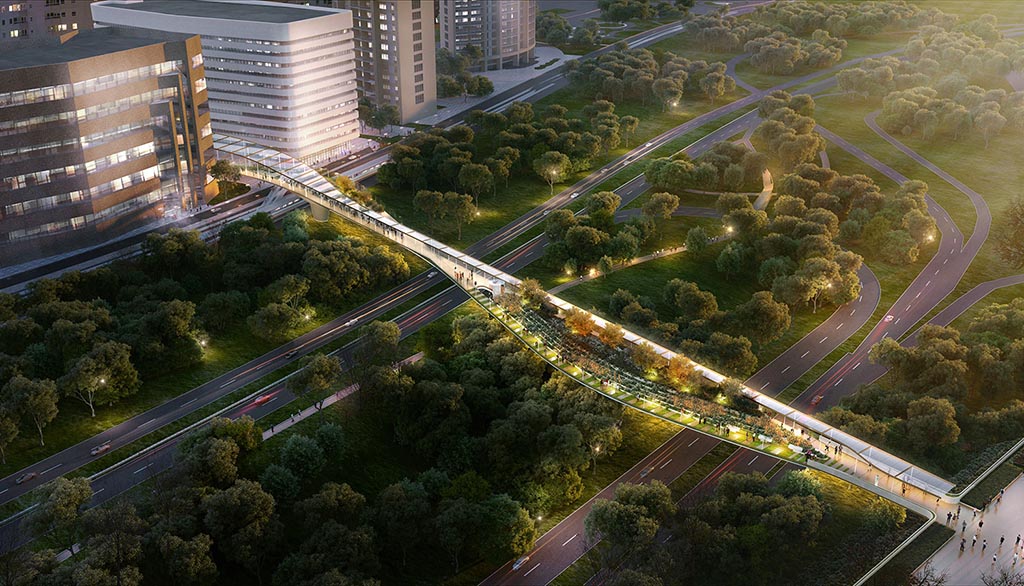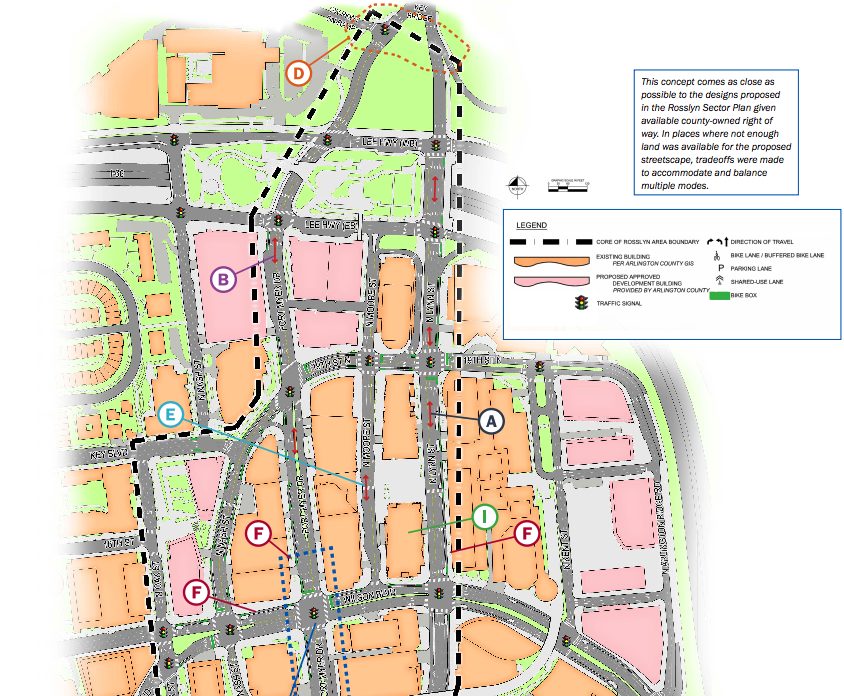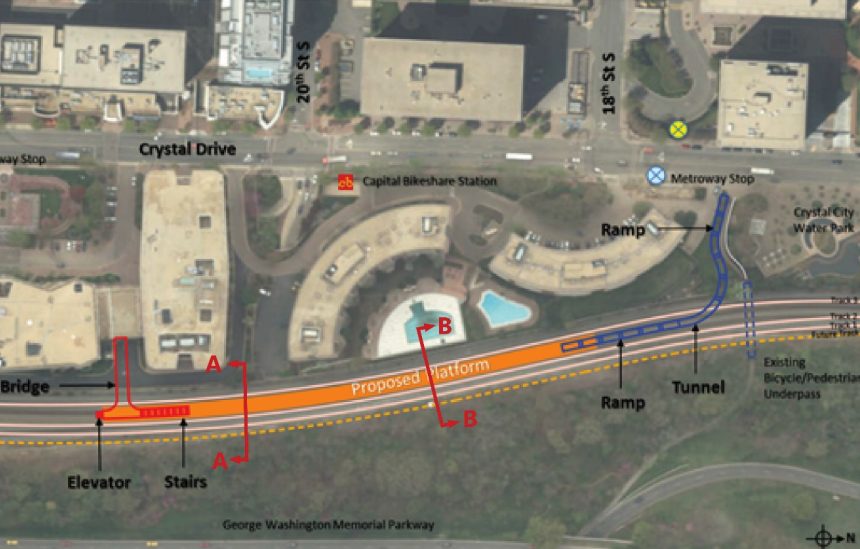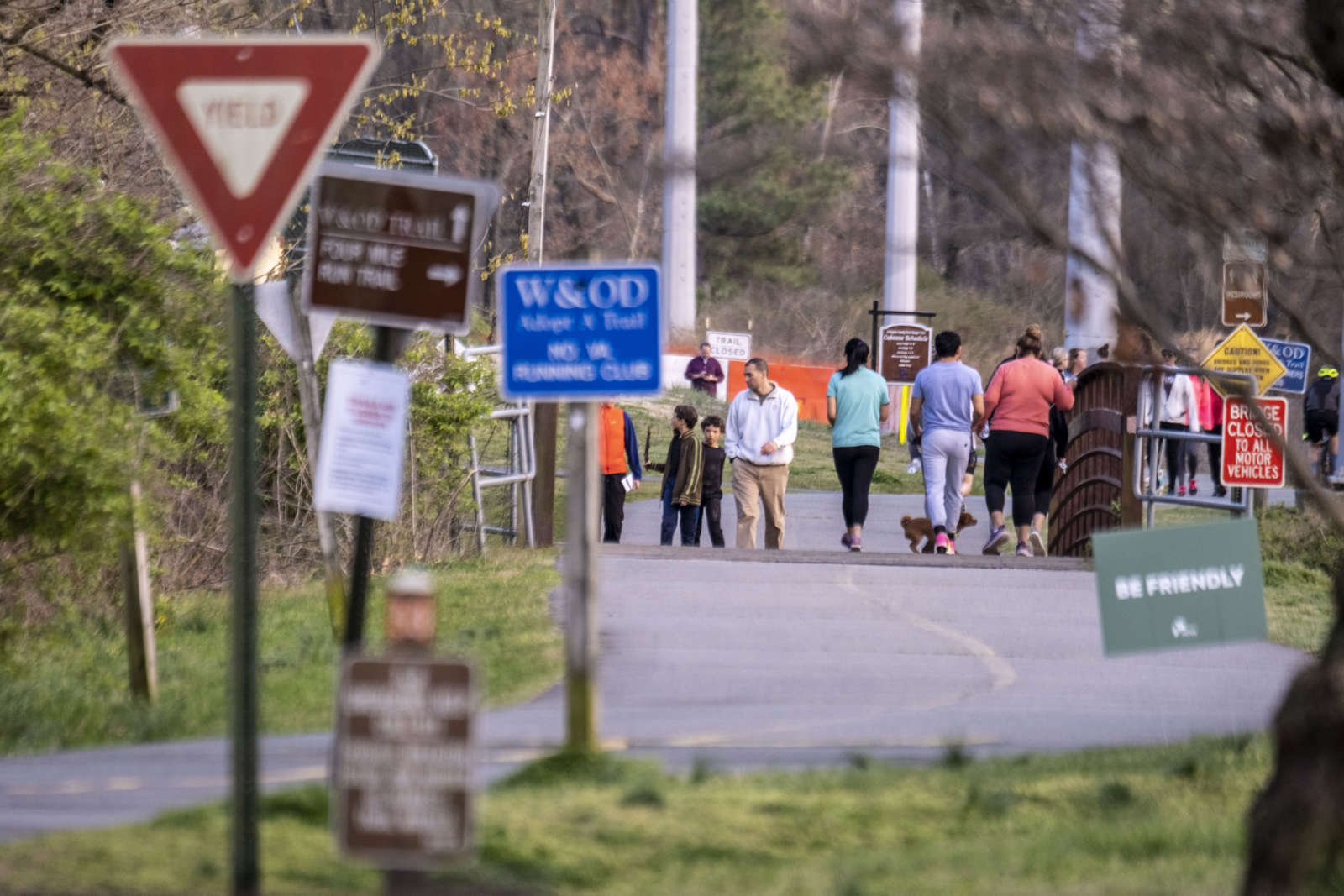Four major transportation projects in Arlington will receive tens of millions in regional funding, the Northern Virginia Transportation Authority announced today.
The projects, all of which are in the planning stages, will bring multimodal upgrades to Crystal City and Rosslyn, as well as to the W&OD Trail. In all, the NTVA is providing more than a half billion dollars in funding to 21 projects around the region.
“On the evening of July 9th, the Northern Virginia Transportation Authority adopted the FY 2020-2025 Six Year Program, the Authority’s fifth funding program and the most competitive to date,” the regional governmental body said in a press release. “$1.44 billion in multimodal transportation funding was requested by 13 Northern Virginia localities and agencies – including Arlington County – with $539 million in Authority regional revenues available.”
“The Authority unanimously voted to fund 21 of the 41 transportation projects submitted for funding consideration,” the press release continues. “Arlington County was awarded $29.874 million in regional revenues on the following projects aimed at reducing congestion and getting people to their destinations faster.”
The projects being funded in Arlington include:
The “CC2DCA” pedestrian bridge from Crystal City to Reagan National Airport, which is envisioned as providing a “High Line“-like experience as it spans the GW Parkway and makes walking to the airport more feasible for those in the National Landing area.
The project is set to receive $18 million from NVTA, of the total estimated project cost of $36.2 million.
The project will create a pedestrian connection between Crystal City and Ronald Reagan Washington National Airport (DCA). It would provide an additional transportation access point to the airport, which is less than one-half mile away from Crystal Drive, but is practically inaccessible by foot today. In addition to the potential reduction in vehicular traffic between the two destinations, the project is located roughly two blocks from the under-design Crystal City Metrorail Station East Entrance and provides a direct connection to bus service on the Crystal City-Potomac Yard Transitway. The CC2DCA Intermodal Connector is intended to connect to the future relocated VRE commuter rail station. The CC2DCA Intermodal Connector project builds upon a recently completed feasibility study prepared by the Crystal City Business Improvement District (CCBID). This project will further evaluate alternatives, complete environmental documentation and approvals, engineering design, and ultimately construct a pedestrian connection between Crystal Drive and the terminals of DCA. The NVTA funding would be leveraged with both State and local funds to completely fund design and construction of the project; the Commonwealth has committed $9,500,000 to the CC2DCA Intermodal Connector.
Rosslyn Multimodal Network Improvements, which is an extension of the Core of Rosslyn study. The study, which was completed last year, calls for major changes to Rosslyn’s road and pedestrian network, including removal of the Fort Myer Drive tunnel under Wilson Blvd and upgrades to crosswalks, sidewalks and bike lanes.
The project is set to receive $11.9 million from NVTA, its full estimated cost, though the project description does not mention the tunnel removal.
Design and construct a suite of complementary bicycle and pedestrian improvements largely taken from the recommended implementation projects in the draft Core of Rosslyn study. Collectively as a package, the projects significantly improve access to employment, housing, and transit within the Rosslyn regional activity center, and improve regional connections between Rosslyn and Georgetown, DC.
The long-planned VRE Crystal City Station Improvements project, which would building a new, upgraded Virginia Railway Express station in Crystal City, the last VRE stop before D.C.
The project is set to receive $15.8 million of its estimated total $49.9 million cost.
This project includes providing a new expanded VRE Crystal City Station that can serve full-length VRE trains on two tracks and removal of the existing station. The new station will have two pedestrian grade-separated access points to Crystal Drive, one at the south end of Crystal City Water Park and the other through the Crystal Park office complex. The station location will enhance connectivity to the local and regional transportation network including more convenient and safer access to the Crystal City Underground, bicycle/bikeshare infrastructure, the proposed second entrance to Crystal City Metro station, the Crystal City-Potomac Yard transitway, kiss-and-ride area, and the proposed walkway to National Airport including the Metro station. Necessary track relocations in the station area will be undertaken to accommodate the new platform. This project will be coordinated with the Commonwealth of Virginia’s fourth track project between Alexandria and the Potomac River, and the pedestrian connection from Crystal City to National Airport (CC2DCA) project. This application is for funding the completion of construction of the VRE station improvements and trackwork. This project will: Enhance station capacity and convenience for passengers; Expand railroad capacity, operational flexibility, and resilience; Improve reliability and on-time performance; Reduce highway congestion; and Reduce transportation-related air pollution.
W&OD Trail Enhancements in Arlington, which would widen a busy, two-mile stretch of the W&OD Trail in Arlington. The plan has been criticized by a group of tree and environmental advocates worried about tree removal and stormwater runoff.
The project is only set to receive $650,000 of the requested $5.6 million, which would have covered the entire cost.
The project is to replace the existing 12-foot wide shared-use trail with a 12-foot wide bicycle trail and an 8-foot wide pedestrian trail separated by a 2-foot wide median. Where the W&OD Trail parallels I-66, the trail will be widened to a 16-foot shared-use trail due to site constraints. Two narrow bridges over Four Mile Run will be replaced with wider bridges. The project extends 2 miles in Arlington County, from N. Roosevelt St. to N. Carlin Springs Rd. and is the first phase of efforts to improve inadequate levels of service along congested portions of the W&OD in Arlington. This project will increase usage of the W&OD and enhance access to commercial and employment destinations. The project will provide greater capacity and encourage bicyclists and pedestrians who may avoid the trail due to overcrowding. The project is a continuation of NOVA Parks’ and the City of Falls Church’s dual trail project to the west. The project will significantly enhance first and last mile access to the East Falls Church Metrorail Station (.13 mile from the project area) and for commuters continuing into Arlington, Alexandria, and D.C. The W&OD in the project area provides access to N. Sycamore Street, Wilson Boulevard, and N. Carlin Springs Road, each with sidewalk connections and direct access to commuter routes. The W&OD connects to the Custis Trail and Bluemont Junction Trail in the project area, offering an opportunity to enhance the connections to these major commuter routes into the Ballston, Virginia Square, Clarendon, Court House, and Rosslyn Activity Centers and D.C. Moreover, the project enhances the commuter route to Columbia Pike and Alexandria. The project also enhances direct bicycle and pedestrian access to Benjamin Banneker, Bon Air, Bluemont and Glencarlyn parks. The 45-mile long W&OD traverses the counties of Arlington, Fairfax, and Loudoun, the City of Falls Church, and the towns of Vienna, Herndon, and Leesburg. The straight and flat paved trail, which follows the gentle grade of the former railroad bed, provides a major bicycle commuter route for Northern Virginia. The trail connects to numerous pedestrian and bicycle facilities to form an extensive non-motorized network throughout Northern Virginia, connecting residential neighborhoods, employment centers, and commercial districts. The popularity of the trail and the wide range of trail users’ abilities present critical challenges related to maintaining capacity and public safety.
Two other projects submitted by Arlington County were not approved for regional funding: a new western entrance for the Ballston Metro station, and a new trail that would run along a portion of Arlington National Cemetery.





